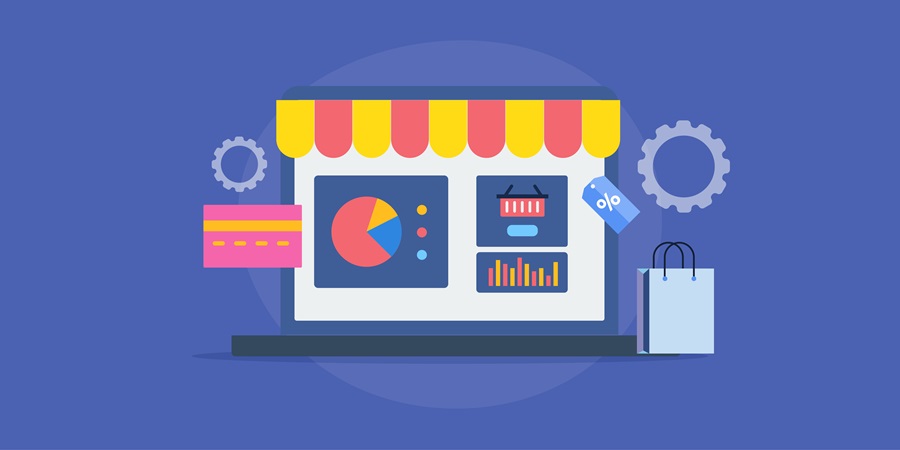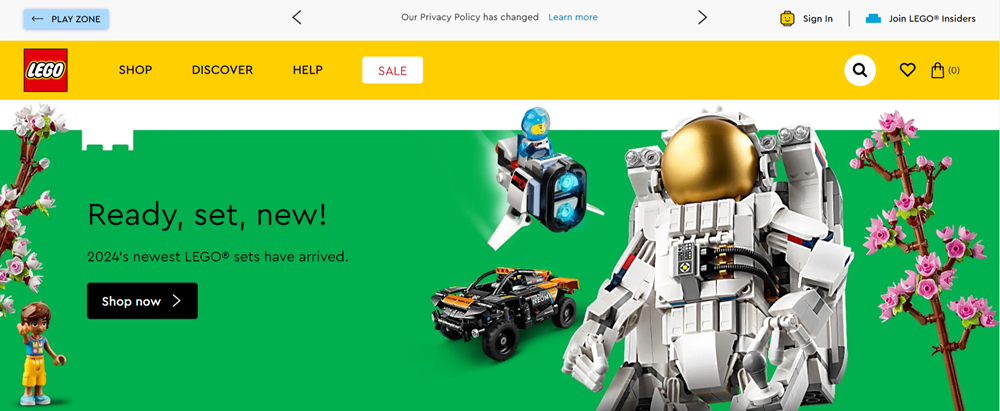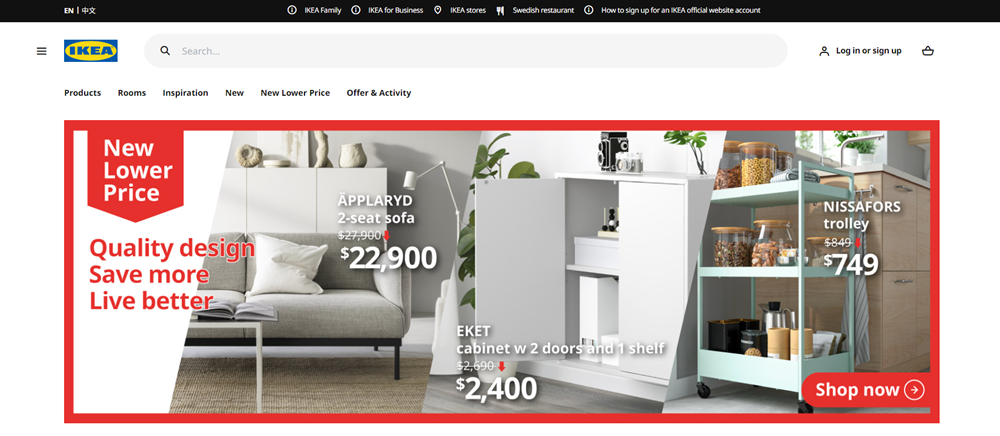Headless e-commerce has emerged as a groundbreaking approach in the world of digital technology. In fact, we’re most often asked by our clients whether or not headless e-commerce is the right solution for their enterprise.
It’s understandable because the term “headless” sounds…vague. Where did the head go, right?
Not to worry. With this article, we will shed light on what headless e-commerce is and if it’s the right option for your online business.
First things first…
What is Headless E-commerce?
Headless e-commerce decouples the front end presentation layer of an e-commerce platform from its back-end functionality.
This separation allows businesses to customize their customer experiences without altering the core commerce functionality.
Think of headless e-commerce as a flexible, agile solution for businesses that want the ability to rapidly adapt to market changes and customer demands.
Ultimately, headless e-commerce provides a unique opportunity to innovate and personalize the shopping experience from any channel a customer accesses.
Why Headless E-commerce?
Headless e-commerce platforms offer unmatched flexibility, enabling businesses to swiftly respond to evolving market trends and cater to customer preferences.
Building headless e-commerce systems can significantly enhance business agility.
These systems allow you to "buy only the features you need," potentially reducing licensing costs and other expenses.
However, we also caution about the web of dependencies that can arise, impacting system reliability and accountability.
8 Challenges and Risks of Headless E-commerce
While headless e-commerce solutions offer considerable advantages, they also present unique challenges.
This isn’t to dissuade you -
It's important for businesses to be aware of these potential issues and plan accordingly to mitigate them.
Let’s get these to the front of your mind before we get into the juicy, fun stuff that makes composable a powerful, scalable, and sustainable solution.
The common risks associated with headless e-commerce include:
1. Complexity in Implementation and Management
Headless e-commerce systems can be more complex to implement and manage compared to traditional, monolithic systems.
This complexity arises from the decoupling of front end and back end systems, requiring a higher level of coordination and technical expertise to ensure seamless integration and operation. That said, more and more headless commerce vendors now provide a “starter front end” — a front end that works with their headless commerce.
➡️ What you need:
A long-term implementation partner that has their “head” on straight and knows this technology inside-out.
2. Dependency on Multiple Vendors
Since headless e-commerce often involves integrating various services and systems (like CMS, CRM, ERP, etc.), businesses may become dependent on multiple vendors. This dependency can lead to challenges in managing relationships, contracts, and SLAs (Service Level Agreements) with multiple parties.
➡️ What you need:
A strong and effective technology implementation plan that addresses the coordination of the entire tech team.
3. Increased Development and Maintenance Costs
The flexibility and customization benefits of headless e-commerce can come at a cost. Developing a custom front end, integrating various back-end services, and ongoing maintenance can require significant investment in terms of time and resources.
More and more vendors, as well as digital technology agencies like Alpha Solutions, provide a number of pre-composed headless commerce solutions. Clients can then start from a configuration that fits their business case, and switch out a single or two components if needed.
This creates the best of both worlds: the flexibility of headless and composable, a fast time-to-market, and better ROI.
➡️ What you need:
To understand how this type of technology solution fits into your overall business growth strategy so that you can invest accordingly.
4. Security Risks
With multiple systems and APIs interacting in a headless e-commerce setup, there can be an increased risk of security vulnerabilities. Ensuring data security and compliance with regulations like GDPR becomes more challenging as the complexity of the ecosystem increases.
➡️ What you need:
A solid cybersecurity compliance plan ensures your organization prioritizes how to understand, mitigate, respond, and recover from any risks.
|
How accessible is your website? Get our free accessibility checklist to guide your efforts for getting compliant and doing the right thing. Plus, receive real feedback from us to help you on your next steps. |
5. Performance Issues
While headless e-commerce allows for more dynamic content delivery across various channels, it can sometimes lead to performance issues. If not properly optimized, the system might suffer from latency issues, particularly if API calls between the front end and back-end are not efficiently managed.
➡️ What you need:
A system built for reliability and optimized performance, to avoid customers abandoning a slow experience.
6. Difficulty in Troubleshooting and Accountability
In a headless setup, identifying and troubleshooting issues can be challenging. Since different components of the system may be managed by different teams or vendors, pinpointing the source of a problem and determining responsibility for fixing it can be complex.
➡️ What you need:
Effective coordination of all team members and outside vendors with a documented troubleshooting and testing plan.
7. Potential for Feature Overload
The flexibility to add numerous features and customizations can sometimes lead to feature overload or 'bloat.' This can negatively impact user experience if not strategically planned and executed.
➡️ What you need:
A streamlined approach to functionality that offers the best experience for the user across all devices.
8. Skillset and Resource Requirements
Implementing and managing a headless e-commerce system requires a specific set of skills. Businesses may need to invest in training existing staff or hiring new talent with expertise in areas like API management, microservices architecture, and front-end development frameworks.
➡️ What you need:
A comprehensive training program for leveling up staff in understanding the headless environment.
While headless e-commerce presents an opportunity for businesses to create more personalized and flexible customer experiences, it's essential to carefully consider all of these risks as a whole.
Adequate planning, strategic vendor selection, investing in the right technical expertise, and ongoing monitoring and optimization are crucial steps in mitigating these challenges.
Headless E-commerce vs Composable Commerce
Headless and composable architectures, while distinct concepts in the realm of digital technology, are closely related and often work in tandem, particularly in the context of e-commerce and content management systems.
As mentioned, in a headless architecture, the front end (or the "head") – which is the user interface and experience part – is decoupled from the back end, where all the data management, business logic, and integrative functionalities reside.
This decoupling allows for greater flexibility in how content or services are delivered to various front-end platforms, like websites, mobile apps, or even IoT devices.
Composable architecture refers to a modular approach where individual components or services of a system can be independently developed, deployed, and managed. Each component, often a microservice, performs a specific function and communicates with other components via APIs.
This modular approach allows businesses to tailor, upgrade, or replace each component without affecting the entire system.
Note: Our aim is to keep this article focused on headless e-commerce, but we have written a detailed article about composable architecture and composable commerce here.
The Intersection: How Headless Relates to Composable
There are, of course, commonalities between headless and composable systems. The key is to implement the best system needed for your business to grow (ask us for our unbiased opinion - that’s kind of our thing).
Take a look at where the headless e-commerce and composable intersect:
Flexibility and Customization
Both headless and composable architectures offer flexibility. In headless systems, this flexibility is seen in the front-end presentation layer, where businesses can create custom user experiences across different platforms. In composable systems, flexibility is inherent in the ability to mix, match, and replace various back-end components as needed.
Agility in Response to Market Demands
Headless architectures allow businesses to quickly adapt their user interface to changing market trends without overhauling the back-end systems. Similarly, composable architectures enable rapid adaptation of back-end functionalities, scaling, or integrating new services without disrupting existing operations.
Tech Stack Diversification
Both approaches allow businesses to choose best-of-breed solutions for different functions. In a headless setup, the front-end developers are not limited by the back-end technology choices. In a composable setup, each back-end service can be selected based on its specific merit, irrespective of others.
Enhanced User Experience and Back End Efficiency
While headless architecture is primarily focused on creating a seamless and dynamic user experience, composable architecture ensures back-end processes are optimized, efficient, and easy to maintain. Together, they enable businesses to create powerful, efficient, and highly adaptable digital platforms.
API-Driven Interactions
Both architectures heavily rely on APIs for communication. In headless systems, APIs connect the back end to various front ends. In composable systems, APIs facilitate interaction between different microservices or components.
To summarize:
Headless e-commerce is about decoupling the front end and back-end to improve the user experience and front-end development flexibility.
Composable commerce focuses on the back end, breaking it down into smaller, manageable, and interchangeable components.
Benefits of Combining Headless E-commerce and Composable Commerce
When headless e-commerce and composable commerce are combined, they offer a powerful approach to building scalable, adaptable, and efficient digital platforms that can evolve with changing business needs and technological advancements.
💪🏼 Enhanced Flexibility and Agility: When combined, headless e-commerce and composable commerce provide a high level of flexibility. Headless architecture allows for diverse and customized front-end experiences, while composable commerce enables the back end to be assembled from various independent services or components.
This combination allows enterprises to rapidly adapt both their customer-facing interfaces and their back-end processes to changing market demands.
📶 Scalability and Performance: Together, they offer superior scalability. The headless approach optimizes front-end performance across various platforms, while composable commerce ensures that the back end can efficiently handle varying workloads and functionalities as the business grows.
⭐ Best-of-Breed Approach: This combination allows enterprises to choose the best possible solution for each aspect of their e-commerce system. They can select the most suitable platforms and technologies for different components like shopping carts, payment processing, inventory management, etc., and integrate them seamlessly into a cohesive system.
Brands that Combine Headless and Composable
Several leading enterprises across different sectors have embraced both headless and composable architectures to drive their digital innovation and e-commerce strategies.
These companies exemplify how combining headless and composable approaches can lead to more agile, scalable, and customer-centric digital experiences.
Nike has leveraged headless and composable architectures to offer a highly personalized and dynamic online shopping experience. By decoupling the front end from the back end, Nike can rapidly update content and features, providing a user experience that is responsive to market trends and customer behaviors.
Electronic Arts (EA)
The video game giant EA utilizes a headless and composable approach for its online platforms. This setup allows Electronic Arts to efficiently manage and deliver digital content, such as game updates and news, across various channels and devices, enhancing the gamer experience.
Lego
Lego has implemented a headless and composable e-commerce system to manage its vast product catalog and to provide a customizable shopping experience. This approach enables them to easily update and introduce new features, ensuring a consistently engaging and interactive customer journey.
Sonos
The wireless home sound system company, Sonos, uses a headless and composable architecture to offer a seamless and cohesive online shopping experience. This setup allows them to integrate various technologies for enhanced product visualization and customer interaction.

Zalando
As one of Europe’s leading online fashion platforms, Zalando leverages a headless and composable framework to adapt quickly to changing fashion trends and consumer preferences. This flexibility enables them to offer a diverse range of products and personalized shopping experiences.
These enterprises demonstrate the effectiveness of combining headless and composable architectures to create flexible, scalable, and highly personalized e-commerce experiences.
By adopting both modern technological approaches, they are able to stay agile and responsive to the rapidly evolving digital landscape and customer expectations.
However, it is possible for enterprises to use headless e-commerce and composable commerce separately, depending on their specific needs and strategies.
Using Headless E-commerce Solutions Alone
An enterprise might opt for a headless e-commerce solution without fully embracing composable commerce.
This approach is typically chosen for its front-end flexibility while maintaining a more traditional, monolithic back-end system.
The use of headless e-commerce alone is beneficial for businesses focusing more on delivering a diverse and rich user experience across various channels and devices.
When adopting headless e-commerce as a standalone strategy, a business can focus on the flexibility and customization it offers for the front-end user experience while maintaining more traditional back-end systems.
Here are some headless e-commerce examples:
Bose
Bose, known for its audio equipment, uses headless e-commerce to provide a highly customizable and responsive online shopping experience. This approach allows them to quickly update their website and mobile interfaces with new product launches and marketing campaigns while maintaining their existing e-commerce infrastructure.
Gymshark
The fitness apparel and accessories brand, Gymshark, employs a headless e-commerce architecture. This setup enables them to offer a seamless and dynamic customer experience across various digital channels, crucial for their predominantly online customer base.
Bang & Olufsen
The high-end Danish consumer electronics company, Bang & Olufsen, uses headless e-commerce to deliver a rich and immersive online experience that reflects the quality and design ethos of their brand. This approach allows them to innovate on the customer interface without overhauling their entire e-commerce system.
Sephora
While Sephora also explores composable commerce, their use of headless e-commerce is particularly notable for enhancing the customer experience on their digital platforms. This approach allows them to integrate various digital beauty tools and personalized shopping experiences.
Lancôme
The luxury beauty brand Lancôme utilizes a headless e-commerce approach to offer personalized beauty experiences and content to its customers. This strategy allows them to rapidly deploy and test new features and content across their global sites.
These enterprises show how headless e-commerce can be effectively utilized to enhance the customer experience, improve agility in content management, and offer personalized interactions, all while maintaining their existing back-end e-commerce systems.
By focusing on the headless aspect, they are able to quickly adapt to market changes and consumer expectations without the need for a complete overhaul of their e-commerce infrastructure.
Using Composable Commerce Alone
Conversely, an enterprise might embrace composable commerce while keeping a traditional coupled front end and back end.
This approach allows for back-end flexibility and the ability to update or replace individual components without overhauling the entire system, which can be beneficial for businesses focusing on back-end efficiency and scalability.
Companies that opt for composable commerce are able to focus on the back-end flexibility and modular nature of their systems while often maintaining a more traditional approach to their front-end user interfaces.
Here are some examples of brands using composable commerce on its own:
HP has adopted a composable architecture to manage its vast array of products and services. This approach allows them to efficiently handle complex configurations and pricing models for their hardware and software offerings, enhancing their operational efficiency without necessarily altering the customer-facing front end.
IKEA
While known for its in-store experience, IKEA also focuses on a composable back-end architecture for its online presence. This strategy enables them to manage a large inventory and complex supply chain efficiently, ensuring a seamless operational flow from warehouses to end consumers.
Siemens
Siemens employs composable architecture in managing its vast array of industrial products and services. This modular approach allows them to efficiently update and maintain different components of their digital infrastructure, which is crucial for their diverse and globally spread operations.
Unilever
The multinational consumer goods company, Unilever, utilizes a composable architecture to manage its extensive product portfolio. This allows for greater flexibility in handling the supply chain, marketing, sales, and distribution of a wide variety of consumer products.
FedEx
FedEx uses a composable architecture to manage its complex logistics and delivery services. This modular approach helps them integrate various logistics, tracking, and delivery systems, enhancing operational efficiency and customer service.
These enterprises demonstrate the effectiveness of composable architecture in providing operational flexibility, scalability, and efficiency.
By focusing on a modular and integrative back-end system, they can streamline their operations and adapt to market changes and business needs without necessarily implementing a headless e-commerce platform on the customer-facing front end.
How do you decide whether to use Headless, Composable, or both?
In practice, the synergy of headless e-commerce and composable commerce is often more beneficial for enterprises, especially those looking to stay competitive in a fast-paced digital market.
This combination provides a comprehensive solution that addresses both the need for an engaging customer experience and the demand for a flexible, scalable back-end.
However, the choice to use them together or separately should be aligned with the enterprise's specific business goals, digital maturity, and long-term IT strategy.
At Alpha Solutions, we categorize companies into three distinct groups regarding the approach to composable commerce:
1. Composable All the Way
These companies are fully committed to composable commerce. They either have the in-house capability to manage the complexities of composable headless systems or partner with technology experts like us to handle their tech and DevOps needs.
2. Targeted Composable
Businesses in this category have a stable system and integrate new, composable components selectively. This approach aligns with true composability—starting with single components and expanding gradually, ensuring faster ROI and directional accuracy.
3. Play It Safe Composable
For companies focusing more on business operations than technology, the key is reliability and trustworthiness. They might opt for a comprehensive system that meets all their needs or rely on a partner like Alpha Solutions to manage a pre-composed headless commerce system.
Which one are you?
We’d be happy to chat with you about whether or not a headless e-commerce solution is the right option for your business.
Our team has successfully helped many diverse businesses implement headless e-commerce platforms after determining it was the best strategic decision for long-term growth and scalability.
Whether you choose composable, headless, or both, selecting the right platform is crucial.
When it comes to choosing the best e-commerce platform for your needs, factors to consider include:
-
Scalability
-
Compatibility with existing systems
-
The ability to support future growth and innovation
At Alpha Solutions, we assess platforms based on their flexibility, feature set, and ease of integration with other business systems, ensuring they align with our clients' long-term strategic goals.
Conclusion
Headless e-commerce is not just a trend but a significant shift in how businesses approach online retail. Its potential for personalization, scalability, and integration with emerging technologies makes it a pivotal component of future e-commerce strategies.
We foresee a future where headless e-commerce becomes the norm, offering unparalleled customer experiences and driving business growth.
Our role as a preferred implementation partner is to guide and support businesses through this transition, ensuring they are well-equipped to thrive in the digital commerce landscape.
Whether you're a business fully embracing composable commerce, selectively integrating new components, or seeking a reliable, managed solution, we offer the expertise and support to navigate this landscape successfully.
As the digital marketplace continues to evolve, with us as your partner, you will not only stay in the game, but you’ll be in a winning position ahead of the pack.
Ready to talk headless? Let’s chat about your goals for e-commerce growth. Contact us today for a no-heads-attached consultation.























